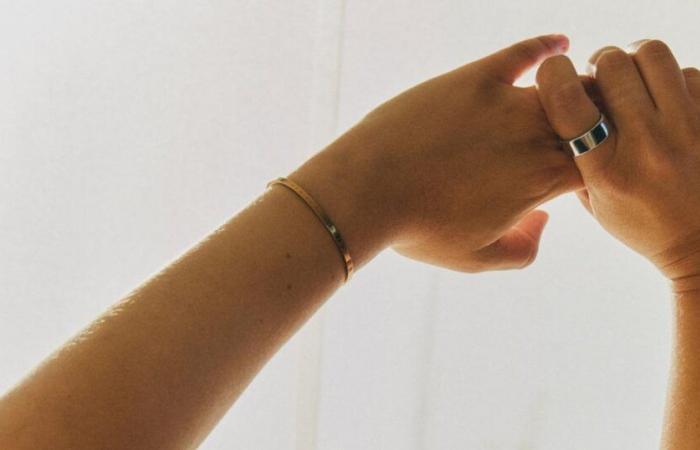A ring to govern… our nights? This is what the Finnish pioneer of connected rings offers with Oura Ring, whose sensors record, among other things, variations in sleep. Decryption with a neuroscience researcher.
The Oura 4 ring is not an ordinary ring, since it commits you to your health, for €399. At least, that's more or less the promise of this high-tech tool, launched in 2015, which houses several sensors recording our physical activity (heart rate, body temperature, blood oxygen level, etc.), our stress level and even our menstrual cycle. And this jewel weighing 4 to 6 grams (depending on the size) not only monitors our actions during the day, it is connected to an application (paid, €69.99 per year) which also collects data on our sleep: the movements, the duration of the night and its different phases, awakenings, bedtime and getting up time. To date, the brand claims to have sold more than 2.5 million rings. Among the most famous users, we include the well-being guru Gwyneth Paltrow, Prince Harry, Cristiano Ronaldo, and recently the actress Eva Longoria, who appeared in early November in Marie Claire US being addicted to his ring, to the point of religiously monitoring his daily amount of deep sleep. But is it really a reliable measurement? Can we really optimize our nights using this data? We take stock.
Also read
These 11 small changes can transform the quality of your nights
Promising statistics
Slow, deep, paradoxical, chronotype sleep… It must be admitted, the science of sleep has elements of language that are not easily accessible to the average sleeper. This is why the Oura brand offers to simplify the message by providing its user with a sleep score, between 0 and 100, every morning on its application. This takes into account the time spent during each phase of sleep, that of falling asleep (less than 20 minutes ideally), the total time of sleep (between 7 and 9 hours depending on the individual) but also compares them with the objectives of sleep that you have set for yourself. And if you want to investigate even further, graphs are at your disposal to see, for example, the evolution of your sleep time over several weeks.
”
data-script=”https://static.lefigaro.fr/widget-video/short-ttl/video/index.js”
>
Is this technology similar to that used by specialized centers for sleep pathologies? Not really. Classically, sleep and its different phases (slow, deep, paradoxical) are measured by recording the electrical activity of the brain using electrodes (an electroencephalogram). The Oura connected ring, like its competitors on the market (Galaxy Ring from Samsung or the Circular Ring from Slim), does so indirectly: they use a sensor which uses photoplethysmography (PPG, a non-invasive vascular functional exploration technique). ) which delivers variations in heart rate during the night, the acceleration or decrease of which would indicate the stages of sleep.
As Maxime Elbaz, doctor of neuroscience and former technical director of the Sleep and Vigilance Center at the Hôtel-Dieu de Paris AP-HP hospital, specialist in digital health, reports to us, several studies have attempted to compare these two methods. and try to validate the process used by the connected rings. The most recent, published in the journal Sensors in 2024, and carried out by researchers from Harvard Medical School in Boston from a small cohort of 34 healthy subjects, presents promising results and shows that the Oura Ring “generally does the job”, according to Maxime Elbaz, of more precisely than other connected objects such as the Apple Watch Series 8 or the Fitbit Sense 2 bracelet, “except for correctly estimating the time it takes to fall asleep,” he says. However, the neuroscientist admits to having some reservations about the objectivity of such work since one of the authors of the said study is also a consultant at Oura…
A prevention tool
Thus, in the absence of conclusive data validated by health authorities, the Oura ring, like most of its competitors, does not replace a medical examination. On the other hand, neuroscience researcher Maxime Elbaz still sees it as a prevention tool in the face of diagnostic wandering among certain patients suffering from sleep pathologies. “The waiting time to get an appointment in a sleep laboratory is very long, sometimes up to six months. But do we still need to be aware of the need to go for a consultation? Insomniacs have a very poor perception of their sleep, which they overestimate, so this ring, like others, can help to realize that there is a problem (a sleep debt, a problem falling asleep or repeated nocturnal awakenings) and the need to consult. » The Oura ring also makes it possible to detect the oxygen level in the blood, the desaturation of which can alert the user to a risk of sleep apnea, but it is less reliable than the Circular Ring Slim or the Apple Watch on this point, because the measurement is not made continuously during the night,” adds the neuroscientist.
Also read
Insomnia: 16 micro-changes to get out of the vicious spiral
Consume in moderation
And in a “healthy carrier”, without sleep pathology? What are the benefits of monitoring your sleep statistics? “It’s helpful in the sense that it encourages good habits, such as having regular bedtimes and waking up times. The duration of sleep must also be taken into account because below six hours, we are exposed to cardiovascular and cancer risks,” reports Maxime Elbaz.
Be careful, however, not to have your eyes constantly glued to the graphs. This quest to “sleep well” can also turn into an obsession. “We call it orthosomnia. As we become addicted to our cell phones, we seek to improve our sleep at all costs. But if you overdo it, you risk developing insomnia,” warns the neuroscientist. Hence the need to take a step back from these devices. For those who are interested in it, and who have the means to afford it, Maxime Elbaz therefore recommends occasional use of the connected ring, from time to time during the year, for a month or two, but not on a daily basis. in a good sleeper. Another alternative mentioned is the sleep diary, where you record your bedtime and wake-up times. Less expensive… but more restrictive.






